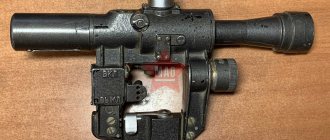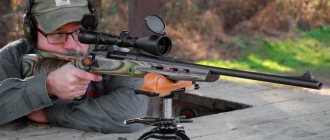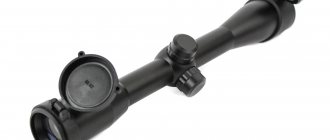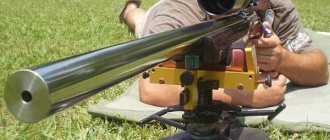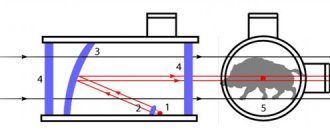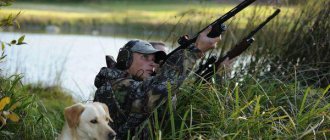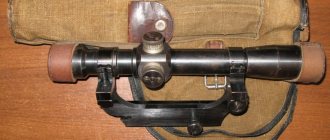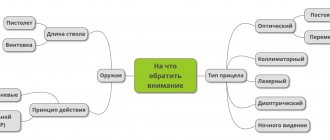- October 15, 2018
- Miscellaneous
- Dmitry Averkin
Driven hunting is one of the most widespread and oldest trades of both forest and steppe animals. Not only experience is important here, but also the chosen weapon and accompanying accessories. Among the latter, a special optical sight (driver) can be called a critical tool.
The modern market for hunting equipment offers a lot of devices of this kind, where sometimes even experienced beaters throw up their hands, not to mention beginners in this matter. And if a dozen years ago the choice came down to a dozen products, today there are many more of them: simple, electronic, small, large and many more from different manufacturers.
We will try to understand this issue and outline the main criteria that you need to pay attention to when selecting an optical sight for driven hunting. This will allow you to make an informed purchase and not regret it.
Types of driven fishing
First, let's define the types of driven hunting. Because the characteristics of future optics largely depend on them. In total there are three main types:
- surge;
- corral;
- raid.
In the first case, we have one beater and several shooters. With a normal corral, the number of both is equal. During a roundup, several types of animals or game are hunted. It is also worth noting that the second type, corralling, can only be carried out during daylight hours.
Experienced fishermen will never participate in this event when there is heavy snow or dense fog. Therefore, large lenses and high-aperture optical sights are not suitable for driven hunting.
Types of driven hunting
Driven hunting is one of the most common and oldest methods of hunting animals. This term combines several varieties, among which are:
- corral (many beaters and many shooters);
- rush (one beater and many shooters);
- roundup (hunting several types of game at the same time).
Even within one type of enclosure, it is impossible to predict in advance at what distance the animal will find itself, at what speed it will move, and one can only guess about the direction of movement. It is for this reason that most hunters prefer to use the most versatile scopes - variable magnification.
It is worth remembering that driven hunting is carried out only during the day to ensure the safety of both beaters and shooters. Even in fog or dense falling snow, experienced rangers will not let their people in. Therefore, powerful aperture (and at the same time expensive) sights are not required here. Although, of course, using an expensive scope increases the chances of earlier detecting the animal, which often appears for a few seconds and hides behind foliage or in the bushes, leaving for another number.
Types of optics
Here, first of all, it is necessary to take into account the distance at which the shooting will take place. Depending on the number chosen or, as a rule, received, you can find yourself either in an open area with a good view or in a difficult thicket. So for an optical sight for driven hunting, the magnification factor (zoom) is very important.
By the way, there is a lot of debate about the latter among professional beaters, so the advice of experienced ones can differ dramatically on this matter. We will look at the most popular options for sights for driven hunting.
- Optics with variable zoom 1/4/6x.
- Collimator sights (usually closed type).
- Tactical optics (types of collimators) with 3x or 4x zoom.
In a good half of cases, each hunter chooses one option for himself. After which he develops skills on this particular driven sight and considers all others to be mediocre options.
So it’s very difficult to say which of the above types of optics is more effective and convenient, because it all depends on your personal preferences. In any case, a test drive of all these driven sights will clearly not be superfluous. We will analyze them in more detail, taking into account the basic rules of this type of fishing.
How to choose an optical sight
Every hunter is faced with the task of choosing an optical sight.
What are the features and what should you pay attention to? Selecting an optical sight .
Which one should I buy? Every hunter, after five years of owning his first smoothbore weapon, is faced with the choice of purchasing a rifled carbine. Along with this decision, it is often worth choosing an optical sight. Although the scope is then purchased again and again, and maybe more than once. But every time the decision is associated with the complexity of choice for various reasons. The first reason is which sight to choose: collimator, optical, night? And it also needs to be reliable, good, so that you don’t feel ashamed in front of your friends... When a decision is made to purchase an optical sight, many questions arise about its characteristics and various technical properties.
Types of optical sights by degree of magnification
1. Sights for driven hunting
have magnification from 1 – 4, 1.5 – 6, 1.6 – 8 times, lens diameter from 20 to 32 mm, not large dimensions and weight 2.
Universal sights
for shooting from 100 to 400 meters (medium distances) have magnification from 2 – 7 to 4 – 12 times and lens diameter from 32 but not more than 50 mm.
These are scopes for medium-range shooting. You can hunt with them during walking hunting, in the mountains and in the paddock. They have a varied selection of reticles. 3. Sights
with higher magnification and a larger lens diameter are considered sights
for mountain hunting, for long-distance shooting.
Such sights are distinguished by increased magnification from 10 to 50 times or more, while their lens diameter usually ranges from 50 mm, and generally from 56 mm.
The dimensions and weight of “mountain” sights are much larger than their “smaller brothers” and they look more powerful. Such scopes are also used by athletes for hunting in the mountains. These sights, depending on the manufacturer, can have a different range of magnifications; in addition, they often use a subtle and important function - parallax adjustment and, depending on the configuration, the possibility of using bullet drop compensators - “ballistic turrets”. Each sight has its own tasks and purpose.
Driven sights are not suitable for high-precision shooting at long distances and vice versa. Choosing the right scope is the key to successful hunting and the satisfaction of getting a successful trophy. Types of optical sights by purpose
1.
Sports.
Sports scopes often have open-type drums for making adjustments during shooting. At the same time, they may have a small adjustment step (click) of less than 1⁄4 MOA (7 mm per 100 m), then 1/8 MOA (3.45 mm per 100 m) and less. Sports ones are more used for sniping, for “high-precision shooters” - this is the name given to professionals in precision shooting at long distances; they, as a rule, have parallax adjustment and complex graduated “thousandth” ballistic sighting reticles, with wind corrections, as for example for “Varmiting” . Graduation is in Mil or MOA. The difference is only in the units of measurement of arc minutes and how many millimeters are in 100 meters from one line to another.
2. Army.
Military sights also have open turrets and differ from sports ones with increased manufacturing reliability and a special type of rangefinder reticle. The line between military and sporting is not clear and it is often difficult to divide scopes into sporting and military. The tactical sight was created for the military, for special forces who use sights in harsh conditions, with rifles with high recoil, in addition, they are widely used in the army, special forces, police and special forces.
3. Hunting.
Hunting scopes, as a rule, have closed drums so as not to disturb the adjustment of the corrections when walking through the forest, or accidentally “grazing” on branches to not disturb the settings.
Sighting marks for optical sights
Optical sights can be divided according to the type of reticle into 2 types: 1.
Hunting
reticle, having the form of a simple or incomplete crosshair, such as the most popular - a cross (Duplex) in various variations and a stump (two horizontal and one vertical line, intuitively converging to the center sighting window).
They are simple and versatile for shooting at short distances of 100 - 300 meters. Aiming is simple - for which it is usually enough to simply point the center of the crosshair at the target and fire a shot. 2. Tactical
sighting marks such as Mil-Dot, Duplex, Parabola, etc. They have a visual gradation of vertical and horizontal deviations in the form of dots, strokes, dashes or cutoffs. The unit of measurement in them is different according to the principle, for example, 1 MOA (1 minute of arc = 2.91 cm at a distance of 100 meters) or 1 MIL (milliradian, thousandth; 0.1 MIL = 1 centimeter at a distance of 100 meters is used).
Price when choosing optical sights
Price is the main factor when choosing. Often, when choosing, we are limited in funds. Having a certain amount on hand, we want to get the best device or the best one at the maximum discount.
There is an opinion that a good scope should cost no less than the weapon itself!
This is true! But this statement is perceived with distrust by beginners. Really, when purchasing a weapon for 50, and sometimes for 150 - 200 thousand rubles, you need to pay the same or more for optics?!
Good optics are the key to success! Clearly visible target, visible without distortion! Optics that, even at dusk, allows you to see through the eyepiece much brighter and more clearly! A sight that will tell you and won’t let you down! A sight that, when aimed correctly, will provide an accurate, clear and effective shot! And when hunting, very often there is only one shot!
If you have limited funds, you need to consider budget models, or it is better to postpone the purchase until you have the required amount and buy a scope of a higher class!
Trademarks, countries of manufacture of sights. What to pay attention to when choosing
There are many nuances in this section.
1. You need to find out how long the manufacturing company has been producing products
. Famous brands have a high price, but all possible causes of defects have been eliminated and the company has earned its “Name” in the market. By purchasing optics from a renowned manufacturer, you can guarantee flawless and trouble-free operation of the device for many years.
2. Producing countries
sights. The Russian market offers products from Germany, the USA, Japan, Austria, China, etc. According to statistics, in the USA there are 5% of hunters, in Russia - 2%, in Europe even less, in Asia hunters are rare. Domestic sights, of course, have a name and association with famous military models, a reliable monolithic mount, but due to the variety of sighting marks, magnification range, variety of optical characteristics... although they are very popular among fans of domestic weapons. The leaders in the production of sights are the USA (Leupold, Night Force, Vortex, Redfield), Germany (Carl Zeiss, Leica, Minox, Docter, Schmidt&Bender, Steiner), Japan (March), Austria (Swarovski, Kahles). These are scopes that are made for hunters and professional shooters.
Many class companies, in order to reduce prices, began production in China and other Asian countries. These brands are Nikko Stirling, Bushnel, Hawke, Vixen. Therefore, when choosing, you need to be more careful.
Very good quality sights are produced by Japanese manufacturers HAKKO, NIKON, MARCH.
They belong more to the tactical and sporting class, but have excellent optics and are very loved by our hunters. Dimensions and weight when choosing a scope
When shooting at a shooting range or stationary conditions, the size and weight of the scope and weapon do not play a role, but the situation changes when it comes to hunting. Every gram counts here! If you take into account all the equipment carried by a hunter: weapons, ammunition, equipment, a backpack, everything necessary for hunting for a day, and if you multiply the weight of the equipment by kilometers, and over rough terrain, with hills and hillocks, then you begin to appreciate every extra gram taken.
Therefore, if we are talking about a chassis, then it is better to choose a sight with less weight, and for a driven one, also with smaller dimensions.
Types of sights by constant and variable magnification
Sights with constant magnification have less weight, they have better light transmission, and better visibility in the twilight, since they do not have a device for changing the scope's magnification, so there are fewer lenses. Better light transmission is especially important for hunting in low light conditions, such as at dusk. Such scopes are better suited for measured hunting, but when shooting at medium stable distances, for example from a tower. When choosing a “permanent” gun, you need to know in advance what distance you plan to shoot at. An additional advantage of such sights is that the “eye relief” parameter is important, which is unchanged, to which the shooter gradually gets used, which increases accuracy and speed.
Variable magnification scopes have a special ring for setting the desired magnification ratio. They are more versatile as they can be used for different types of hunting. For example, for driven hunting, you can set the magnification to a minimum, and when shooting at long distances, you can set the magnification to a higher magnification, in accordance with the required distance.
Types of mounting optical sights
As a rule, optical sights are mounted on a tube with rings or on a bracket. There are three types (diameters) of mounting optical sights
Rings with a diameter of 25.4 mm
· Rings with a diameter of 30 mm
· Rings with a diameter of 34 mm
There are other mounting options - on a tire; for example, Swarovski and Schmidt & Bender produce sights with such mounts. Such brackets are produced by many companies, they are monolithic and the cost can vary significantly.
Rings and brackets are divided into three main types:
· Low – for driven sights;
· Medium – for universal sights with a lens diameter of up to 50 mm;
· High – for sights with a large lens diameter of 50 mm or more.
The lower the height, the better for further convenient “nesting” into the sight. But if you buy a scope with a large lens, then you need to take into account that you will also have to buy high rings. Often, experienced gun owners, knowing the peculiarity of the configuration, purchase low rings with a height of VH = 12 mm from the base of the rings to the bottom of the ring, ensuring the lowest possible installation of the sight, when there is a gap of about 3 mm between the lens and the upper part of the barrel, the optimal size of the gap when installing the sight . When installing, the sight must be leveled horizontally by carefully tightening the screws with a force of 15 to 30 kg per 2.5 cm. When installing, be sure to use a thread locker. It is better to entrust this work to a professional installer. Thereby protecting yourself from mistakes, and you don’t have to spend money on a tool.
Often, when purchasing a scope, one is “chasing” for a large lens diameter and high magnification. In fact, a diameter of 40-42 mm is not necessarily quite sufficient. When shooting up to 350 meters, a magnification of 4-6x is usually sufficient. More is extremely sharply used. To select a scope based on the diameter of the lens, you need to know that more light passes through a lens with a diameter of 50 mm by only 42% than through a 42 mm lens, and this is practically unnoticeable. At the same time, a scope with a 42 mm lens will be noticeably lighter than a scope with a 50 mm lens.
Parameter Exit pupil diameter
This is an important indicator, which is calculated using the formula: Ratio of Lens Diameter to Magnification. What you need to know here: if the diameter of the exit pupil is small, for example 4 mm or less, then with a quick shot, when there is little time to aim, you can miss, since it is difficult to clearly see the aiming mark without darkening (crescents).
Eye relief option
This indicator indicates two important things. The first is safety - the distance from the shooter’s eye to the eyepiece, the larger the indicator, the better. This figure should not be less than 90mm to avoid injury from recoil. Secondly, if you remove the eye more than this parameter, you will not see anything. When choosing a sight, you need to take this indicator into account, especially when installing it; if the sight is close or far away, you may encounter problems. The distance from the eye to the eyepiece should be equal to this parameter. The shooter should not “reach” for the sight; this can lead to a miss when firing.
line of sight
This indicator is important and the higher it is, the better. The better the target will be visible, the easier it will be to find. For driven sights this figure can be 40 meters or more (at 100 meters). When choosing scopes with a field of view of less than 2.5 meters, you need to be careful, as it will be difficult to “catch” the target.
Parallax
This is the effect of a mismatch between the focus of the object and the reticle. There are sights with parallax adjustment and with fixed parallax (manufacturers from the factory at a distance of 50 to 100 meters, which is indicated in the instructions).
There are two types of parallax adjustment, either on the lens and on the side (third adjustment dial). In the first case, the lens rotates along its axis and marks with the detuning range are marked on it. In the second case, the drum is located on the left (under the left hand) and also has markings with distances at which there is no parallax.
Parallax adjustment on the lens
Lateral parallax adjustment
When shooting at distances of up to 300 meters, parallax is not noticeable and does not affect accuracy; the deviation at 500 meters is no more than 2-3 cm, but it is important for shooting at long distances. You can understand whether there is parallax or not by setting the magnification factor to the maximum value, shaking your head up and down and to the sides, then on the target you can see how the aiming reticle “walks” along the target.
For ease of adjustment
parallax, there are special
adjustment wheels
that fit on the side parallax adjustment drums and allow you to adjust the alignment of focal planes without changing the shooting position.
Drums of amendments
There are 2 types:
Closed
— with screw caps that protect the adjusting mechanisms from damage and displacement.
Open
– they have the ability to make adjustments quickly during the shooting process; tactical designs of open drums have a fixation so that the settings do not get lost.
Closed drums
look like in the photo. The drum covers are already unscrewed:
Open drums
:
The choice of drums depends on the nature of the shooting and the need for frequent adjustments.
1st and 2nd focal plane reticle location
The image (the picture that the shooter sees) passing through the sight to the eyepiece, “turns over” and focuses 2 times. The first time this happens approximately in the middle of the sight, in the area of the correction unit, the second time it happens closer to the eyepiece. These places are called the first and second focal plane.
Why does a shooter need to know this? These are the places where the aiming reticle can and is located, i.e. it is located either in the first or second focal plane and this is important for the shooter.
If the reticle is located in the first focal plane, then when the scope magnification changes, the size of the reticle also changes. The ballistic parameters of the reticle are preserved when changing the multiplicity. This is convenient when using reticles such as Mil-Dot and “thousandth” reticles, in which the angular parameters of the reticle are the same at any magnification (1 MOA at 100 meters - 2.7 cm, and at a distance of 500 meters 5 times more - 13.5 cm ). This is important and convenient when making corrections and measuring distances. This quality is important when shooting at long distances, for sniping and precision shooting.
When the reticle is located in the 2nd focal plane of the scope, then when the scope magnification changes, the image of the reticle does not change - it does not “get closer” and does not “move away”. This has its advantage. The reticle does not “cover” the target, does not “thicken” - the lines do not become thicker as the magnification increases, and this does not interfere with the shooter. This reticle arrangement is usually used in scopes for driven and running hunting. If the scope uses a Mil-Dot or BDC ballistic reticle, then its angular parameters only work at maximum magnification. You can also measure the distance and make corrections correctly, but if you reduce the magnification, the grid stops working.
Comparison of images through the reticle in the first and second focal planes when changing the lens magnification
:
Illuminated reticle
Illumination is very important when choosing a scope. When shooting during daylight hours at targets or clearly and clearly visible targets, when the grid lines will not merge with the target or terrain, backlighting is not needed. But when you are aiming an animal in a dark forest or in bushes, when the reticle lines can merge with the visible image, a bright central illuminated dot will help you not to lose the center of the crosshair. Illumination is also relevant at dusk, in winter, when the light background is black, gray and white. But we must take into account the fact that if you stay in low temperatures for a long time, the battery may freeze and the backlight will not work.
The presence of illumination is important, especially during driven hunting, as it reduces aiming time if the hunt takes place in the forest and the aiming reticle merges with branches and bushes when aiming. But, illuminated sights have a little more weight and, as a rule, are more expensive. Therefore, when choosing, you need to understand the need for lighting.
The backlight can be of different types - a dot, a cross, a circle, or various combinations of dots, a circle and a cross. The color of the reticle can be red (usually this is the case), but also green; some manufacturers have 36 colors of reticle illumination (Leapers).
Illuminated sights can be found in the Illuminated Reticle Sights section.
Reticle
Common reticles are:
Mil-Dot
, one division of such a grid is equal to 1 MOA = 10 cm per 100 meters. It is comfortable and versatile. There are varieties of HalfMilDot with a division price half as much - 0.5 MOA and even less.
Horus
, such a grid has many divisions, usually below the crosshair. Graduation is 0.2 MOA. This is convenient for shooting at distant targets, taking into account distance, wind correction, etc. Such reticles are used for targeted shooting over long distances, for example in Varminting. For such shooting, a ballistic calculator is usually used. Careful use of such a grid and calculator with the proper skills allows you to make maximum use of the weapon the shooter has.
Ballistic
- ballistic. This grid looks like a cross with divisions in hundreds, vertically and horizontally. In this case, the sight is zeroed: at 100 meters in the center, at 200 meters - 1 division to the bottom, at 200 meters - 1 division even lower, etc. This reticle is used for shooting up to 500-600 meters. Sometimes a rangefinder scale is used to estimate the distance to the target and the ability to take into account wind corrections.
Examples of ballistic reticles:
Hunting
grids –
Duplex, Cross, Stump
, . The idea behind these reticles is simple – point your crosshairs and shoot. With their help, it is difficult to measure distance and adjust shooting. They are simple and work at distances up to a maximum of 500 meters. And even this kind of shooting requires experience.
Optics coating
Modern optical sights have a fairly high degree of coating in the optics. All well-known manufacturers of foreign sights use high-quality coating. The picture turns out to be high-contrast, clear, more saturated and detailed. It is recommended to carefully protect such optics, store them in a case and take care of them, wipe them with special wipes after hunting, thereby saving them for a long time.
Ballistic Turret
A ballistic turret is a special drum or ring with range markings. This is convenient if it is possible to attach the scope to distances of 100, 200, 300, 500 meters or more; just turn the ring to the appropriate division before shooting. If there is no ballistic turret, then it is more difficult to adjust the shot, but it is possible using grids with divisions.
Type of ballistic turret:
Using a turret greatly simplifies targeted shooting at targets when the distance to the target can be measured and the same type of ammunition is used.
This section does not cover sights without magnification, such as red dot sights. To select a collimator sight, you need to go to the appropriate section.
In general, you need to approach the choice of an optical sight not from the position of “inexpensive” or “mediocre”, but to understand how to choose an optical sight, in details and characteristics, pay attention to the choice of reticle and the need for illumination, as well as the diameter of the lenses and the degree of magnification . It is better not to save too much and give preference when choosing to well-known manufacturers with extensive experience. Don't forget to take care of your scope and its optics, and it will delight you for many years.
Variable zoom optics
Experienced fishermen firmly believe that optical sights for driven hunting must have variable magnification. This enterprise is not an individual trip, where you clearly know who, how and under what conditions you will hunt.
In our case, the number is determined by the main beater. And you may find yourself both in well-covered areas and in places where you can work exclusively at short distances. So here you may need both one and six times magnification.
It's also worth noting that driven scopes should start at 1x or 1.5x. This greatly facilitates offhand aiming at short distances. In this case, the optics work as a collimator sight, so you can fire without squinting your eyes, which allows you to double the field of view.
Zagonnik - optical sight with variable magnification
As a rule, a “beater” is an optical sight that has adjustable magnification. Since the main beater (the huntsman) sets the numbers, you can find yourself in places with both long and short distances.
It requires some skill to rotate the magnification adjustment ring directly while aiming, especially in winter when wearing gloves. You need to understand that the beast can only be on your line for a few seconds. Therefore, it is better to play it safe and set a certain multiplicity value in advance.
The magnification of a scope for driven hunting usually starts at 1x (for example, Nikon ProStaff 7 1-4×24 M). This is necessary for quick detection and aiming, especially if the distances are short. At 1x magnification, the optical sight works like a collimator sight, which allows you to shoot with both eyes, thereby expanding the field of view.
The maximum multiplicity value is up to 4x. Sights with a large upper magnification threshold are chosen for greater versatility, for example, if you plan to hunt in open areas - in the steppe or in the mountains. For a driven scope, 10x is still too high: with such a magnification, even catching a fast-moving animal in the visible field of the scope will be a problem. However, in open areas you can use a tripod or bipod.
The diameter of the objective lens (due to the lack of aperture requirements) generally has a small value of 24 mm. A small lens allows you to reduce the size and weight of the sight. Together with that:
Greater aperture is provided by driven sights with a lens of at least 40 mm. This sight will become the main one for your weapon on any hunt!
An important option for the beater is the illumination of the aiming mark. Despite the fact that driven hunting is carried out during the day, in conditions of dense vegetation, illumination will help out against the background of dark bushes, trees, at dusk, as well as on a bright sunny day, when the aiming mark is not visible due to large amounts of light. On some sights, only the central dot is illuminated, which turns the optical one at 1x into a full-fledged collimator and allows you to aim with both eyes. As an example, we can cite the relatively inexpensive Hakko Hunter 1-4×20 sight, which has several reticle options (specify when ordering).
Based on the above considerations, when choosing a pen, we recommend installing one of the following sights:
- Yukon Jaeger 1.5-6x42 - Belarus,
- Hawke Endurance 1.5-6×44 IR(L4a) - UK,
- HAKKO OL-Majesty 1.5-6×42 - Japan.
Of the listed sights, the Japanese Hakko beater, although somewhat more expensive, is the one that provides the best viewing angles at both low and high magnifications.
Sometimes a sight for driven hunting is installed so that it remains possible to aim with an open (mechanical) sight of a weapon. This is especially useful for scopes with low initial magnification, such as the Bering Hunting Series 2.5-10x50, which has a lower magnification threshold of 2.5x. In this case, obviously higher sight posts or a high side bracket are selected.
Additional features include filling the inside of the optical sight with inertial gas. This property will help to avoid internal fogging of the scope.
Optics Features
As for the maximum magnification of the hunting pen, you should not select scopes higher than 10x. As such, sniper fire is not entirely appropriate here, because the driven out animal is quite timid and will not stand still. And a decent zoom (after 10x) implies working with a more or less static target.
The best option here would be 4x and 6x. If you are planning a room for a sniper in the paddock, then it would obviously be useful to take additional care of bipods, tripods and other equipment to facilitate firing at long distances.
Almost all driven optics have small dimensions and weight, which is a significant plus for this type of fishing. The diameter of the main lens ranges from 24 mm, which is quite small compared to other classic sights.
Zeiss Varipoint 1.1-4×24 T*
What can I say, a very high-quality sight, everything is well done, from the body and the fit of parts to the optics. All controls are very smooth, soft and precise. The optics are simply amazing, the picture is bright, clear and contrasty. 30 mm. the pipe looks convincing and classy; this diameter makes it possible to make it 24 mm. lens without any extensions on the body, which makes the design of the sight stylish and traditional. The aiming mark is a dot, a small dot in the field of view and nothing else, no reticles, stumps or guide threads. This reticle design is clearly not for everybody. Laconic and simple, because in the paddock there is no need to introduce corrections for distance, and corrections for the movement of the animal are made by extension. On the other hand, if the point falls on the background of the forest, it is lost, additional threads would help. This is where the backlight helps: when it is turned on, a small “coal” lights up, which is clearly visible under any conditions. And of course, like all Zeiss Varipoint scopes, it is completely sealed and filled with nitrogen to prevent fogging.
KAPS
The test included two KAPS sights: KAPS 1-4×22 BA (illuminated) and KAPS 1-4×22. The almost twofold difference in price makes the choice between these sights quite difficult... In general, KAPS sights look very attractive, excellent, classic design, good production and assembly quality, excellent optics, by the way, Kaps optics are equipped with Zeiss optics. This is immediately obvious - an excellent picture, almost as good as the previous Zeiss. The backlight control, like Zeiss, is located on the adjustment drums, although, in my opinion, the version without backlight looks more attractive, more stylish, or something.
Both scopes are sealed, nitrogen purged and vision corrected. A special feature of the capsule is its greater eye relief - 85 mm. Those. The eye is located slightly further away than on conventional scopes, which can be quite useful when shooting large caliber rifles. The reticles were ordinary, on the sight without illumination there was a stump with additional horizontal threads, on the sight with illumination there was a cross, an illumination in the form of a dot.
I didn’t like the very tight operation of the zoom lens and the diopter settings, and at both ends. Otherwise everything is very good.
Trijicon AccuPoint 1.25-4×24 TR21R
The sight has an inch tube, so to achieve a 24 mm lens the designer had to increase its diameter; the sight immediately lost its traditional appearance and became similar to most conventional field sights. The sight has a very interesting backlight, it is based on light guides. The light is collected on a special “window” on the surface of the sight. The window is a bud of light guides and is transmitted to the tag. The mesh itself is also original, in the form of a hemp. The light mark is a triangle at the top of the stump. The idea of such illumination is simple and beautiful: the brighter the lighting, the brighter the mark glows; when it gets dark around, the mark becomes faded, but always clearly visible. A very smart solution, no batteries, no regulators, everything is simple and works great. The aiming mark can be red or yellow.
The optics themselves are also very good, although not as contrasting as Zeiss or Kaps, but bright and clear. The sight is completely sealed and filled with dry nitrogen. The case is light and durable, the manufacturer guarantees resistance to any caliber.
Nikon Monarch UCC 1.5-4×20
A classic-looking pen based on an inch pipe, it had to pay for this with a lens diameter, as the name suggests, it is 20 mm. Not bad optics, a very decent picture, but the sight did not immediately impress me, even by eye the image quality is worse than in AccuPoint, not to mention Zeiss and Kaps. In general, the general appearance of the sight, the material and painting of the body are not much different from the “good Chinese” ones; if it were 25-30 percent cheaper or had a backlight, it would be a good choice for a budget shooter. And so the hands themselves reach out to AccuPoint. The sight is sealed and, like everything in the test, purged with nitrogen. Classic cross mesh. Throughout the entire test, the zoom lens was annoying, the fact is that the magnification in it changes in the opposite direction, by the way, it rotates smoothly and softly.
Optionality
If you work equally successfully with both the front sight and the whole thing, and with optics, then you should pay attention to the presence of quick-release mounts on the latter. Although they are noticeably more expensive than options with “eternal” installation, they greatly facilitate the fishing process.
As additional options, many experienced beaters recommend devices with illuminated reticle. Although hunting takes place during the day, such assistance will not hurt people with impaired vision and will also make hunting easier.
Collimator sights
The use of this type of equipment is quite justified if we are talking about working at short distances, with not the best visibility. Professional beaters strongly recommend that beginners begin their acquaintance with this type of fishing with collimator sights.
But there are some subtleties here too. The collimator works great on smooth-bore weapons - shotguns and hunting carbines. While on rifled rifles it will only get in the way. On shotguns, zoom is completely useless. It's more confusing than helpful. In addition, the owner of a smooth-bore weapon is unlikely to receive a long-range number. But again, some hunters prefer to use collimators everywhere and always, so it’s a matter of taste, habit and experience.
There are also universal kits, where an optical sight works in tandem with a collimator sight. That is, at short distances the latter is mounted, and at long distances the first is quickly installed. The cost of such kits is quite steep. As mentioned above, quick-release equipment is not cheap.
Testing
This time we decided to limit ourselves to contemplating the sights, or rather through the sight. Let me simulate the following situation: we simply choose a sight for ourselves. We considered that shooting Zeiss or Kaps is a thankless task; the first has proven itself long ago and firmly, the second gives a 25-year guarantee for any caliber. There are AccuPoint and Nikon Monarch left, but if we really like one of them, we’ll shoot it later...
So, the first part of the test is purely subjective picture quality. Here, without a doubt, Zeiss has no competition, a clear, bright, contrasting picture, this can be seen even in photographs. Caps is not far behind, it’s hard to even say in what way, maybe this is generally a subjective influence of the brand? It seems that Zeiss is our everything, but we don’t know Kaps at all. Objectively there is nothing to attach to. In third place is AccuPoint, the picture is bright, but not so contrasting. The last place goes to the Nikon Monarch, the picture not only lacks contrast but also seems not so sharp, less prominent or something... The controls are best on the Zeiss, light and clear, worst of all on the Kaps, very tight zoom and diopter settings, if diopters are still possible Sorry, after all, they are adjusted once or twice, then the zoom should turn easily. Second place goes to Nikon, third place to AccuPoint. Among the reticles, only the Zeiss point is suspicious; I would like to see how to set the horizontal when installing such a sight on a rifle, and this is important! But as a shooting reticle it’s very good, especially with the backlight on. I especially liked the AccuPoint grid, one might even say I unexpectedly liked it, a very successful triangle and stump, and most importantly, it always glows with the “correct” brightness. In the sun it looks like a bright coal, in the twilight it is pale, but clearly visible.
The second part of the test took place at dusk, we set the task of when it would be impossible to distinguish the target object through the sight.
The interesting thing started almost as soon as it began to get dark. In AccuPoint it was visible, just like with a normal eye; if you see an object without a scope, it is visible even with a scope, but in Zeiss and Kaps it was visible better! What the ordinary eye could not discern, could be seen through the sight, an interesting feature. Nikon had the worst visibility, and he was the first to give up; soon it was not only the reticle that was invisible, but also nothing at all. AccuPoint lasted a little longer, about 10 minutes, the backlight was visible when the image became dark and difficult to see. Zeiss and Kaps “went out” after another 10 minutes, giving a completely unrealistic sensation of seeing a world plunging into darkness.
Tactical sights
This is a kind of hybrid between classic optical sights and collimator equipment. They are widely used for military purposes during combat operations and, due to their effectiveness, along with versatility, the “tactics” were adapted to civilian, that is, hunting needs.
Such equipment is compact in size and the principle of operation of the sight is more similar to collimators. But unlike the latter, the “tactics” have special lenses for zoom. They are not up to standard optical sights. The maximum multiplicity of tactical equipment is 4x.
Conclusions.
What conclusions can be drawn: a backlight is needed on the sight! It helps not only at dusk, but also during the day if the object is against a dark background. Of course, the leader of the test is the Zeiss Varipoint 1.1-4×24 T*. Caps are not far behind it and are inferior not even in optics but in “control levers,” but they gain a little in price. Nikon Monarch UCC 1.5-4×20 loses in all respects except price, but I would like it to be lower, for the demonstrated consumer properties. Personally, I liked the Trijicon AccuPoint 1.25-4×24 TR21R the most in terms of money/opportunities received; of course, its optics are worse, the design is also not brilliant, but the backlight and price make it very attractive.
In general, if you have no budget restrictions, take Zeiss or Kaps, choose a suitable grid and I think in the next 25 years, you will not regret it. But if price matters, choose Trijicon AccuPoint.
Distinctive features of optics
Such sights are designed to work at close and medium distances. The abundance of settings and add-ons requires the user to have considerable experience in handling such equipment. So, in the hands of a beginner, such a sight will be practically useless, because he will not be able to fully reveal its capabilities and will be “dumb” at every point. Well, experienced beaters quite often use such advanced equipment, making the hunting process much easier for themselves and others.
In the process of fishing one has to deal with different types of game and animals. If we are talking about a moose, then you can recognize it at long distances and take aim properly. An accurate shot will protect both you and other hunters from wounded animals.
When a wild boar is being corralled, we are talking about overgrown terrain, as well as close range, where there will not be time to take good aim. The optics should be suitable for hunting any driven animal, that is, be practical. Or your weapon should be equipped with a universal mount, where zooms, collimators and tactical devices can be changed with due speed.
Summarizing
When choosing a sight for a pen, first of all you need to pay attention to the possibility of changing the magnification during aiming. If you are new to this business, then you should not look closely at powerful optics. The best option in this case would be collimator devices.
Also, be sure to weigh the scope in your hand. Advanced and multifunctional optics weigh a lot, but they are needed for a different type of hunting. But here, to get to your room you will have to walk a considerable distance. And if the drive is in winter, then every gram will feel like a kilogram.
Also, you shouldn’t immediately buy yourself a fancy tactical sight if you are just learning the basics of this matter. The use of such equipment should be based on experience. Yes, “tactics” can do a lot of things, but you need a specific approach to it, you can’t take it at once, only experience will help here.
Results
- The fundamental factor is the ability to change the magnification during the hunt;
- For beginners, who will be placed on numbers with a short distance, red dot sights are best suited, but experienced hunters should take an optical sight-driver;
- The sight should have small weight and dimensions, since you still need to reach the corresponding number;
- The use of a tandem magnifying attachment and a red dot sight should be based on experience, the attachment should be able to be quickly installed, and the system should have a single optical axis;
- Tactical sights have their own specifics; they may not be convenient for driven hunting.
